belt BMW M3 COUPE 2001 E46 Owner's Manual
[x] Cancel search | Manufacturer: BMW, Model Year: 2001, Model line: M3 COUPE, Model: BMW M3 COUPE 2001 E46Pages: 183, PDF Size: 1.65 MB
Page 10 of 183
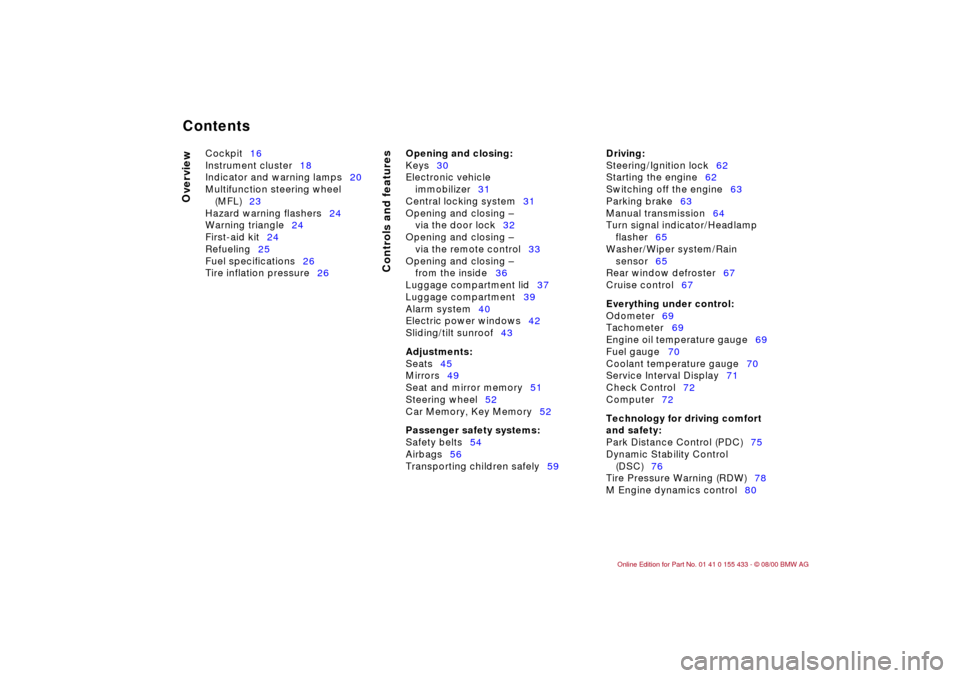
Contents
Overview
Controls and features
Cockpit16
Instrument cluster18
Indicator and warning lamps20
Multifunction steering wheel
(MFL)23
Hazard warning flashers24
Warning triangle24
First-aid kit24
Refueling25
Fuel specifications26
Tire inflation pressure26
Opening and closing:
Keys30
Electronic vehicle
immobilizer31
Central locking system31
Opening and closing Ð
via the door lock32
Opening and closing Ð
via the remote control33
Opening and closing Ð
from the inside36
Luggage compartment lid37
Luggage compartment39
Alarm system40
Electric power windows42
Sliding/tilt sunroof43
Adjustments:
Seats45
Mirrors49
Seat and mirror memory51
Steering wheel52
Car Memory, Key Memory52
Passenger safety systems:
Safety belts54
Airbags56
Transporting children safely59
Driving:
Steering/Ignition lock62
Starting the engine62
Switching off the engine63
Parking brake63
Manual transmission64
Turn signal indicator/Headlamp
flasher65
Washer/Wiper system/Rain
sensor65
Rear window defroster67
Cruise control67
Everything under control:
Odometer69
Tachometer69
Engine oil temperature gauge69
Fuel gauge70
Coolant temperature gauge70
Service Interval Display71
Check Control72
Computer72
Technology for driving comfort
and safety:
Park Distance Control (PDC)75
Dynamic Stability Control
(DSC)76
Tire Pressure Warning (RDW)78
M Engine dynamics control80
Contents
Page 12 of 183

Contents
Owner service procedures
Advanced technology
Technical data
Replacement procedures:
Onboard tool kit138
Windshield wiper blades138
Lamps and bulbs138
Repairing a flat tire145
Battery148
Fuses151
Microfilter/Activated charcoal
filter152
In case of
electrical malfunction:
Fuel filler door152
Sliding/tilt sunroof153
Giving and receiving
assistance:
Jump-starting154
Towing155Airbags158
Radio reception158
Dynamic Stability Control
(DSC)159
Safety belt tensioner159
M3 Engine concept160
Rain sensor160
Interior rearview mirror with
automatic dimming
feature161
Self-diagnostics162
Xenon lamps163Engine data166
Dimensions167
Weights168
Capacities169
Electrical system170
Drive belts170
Page 19 of 183
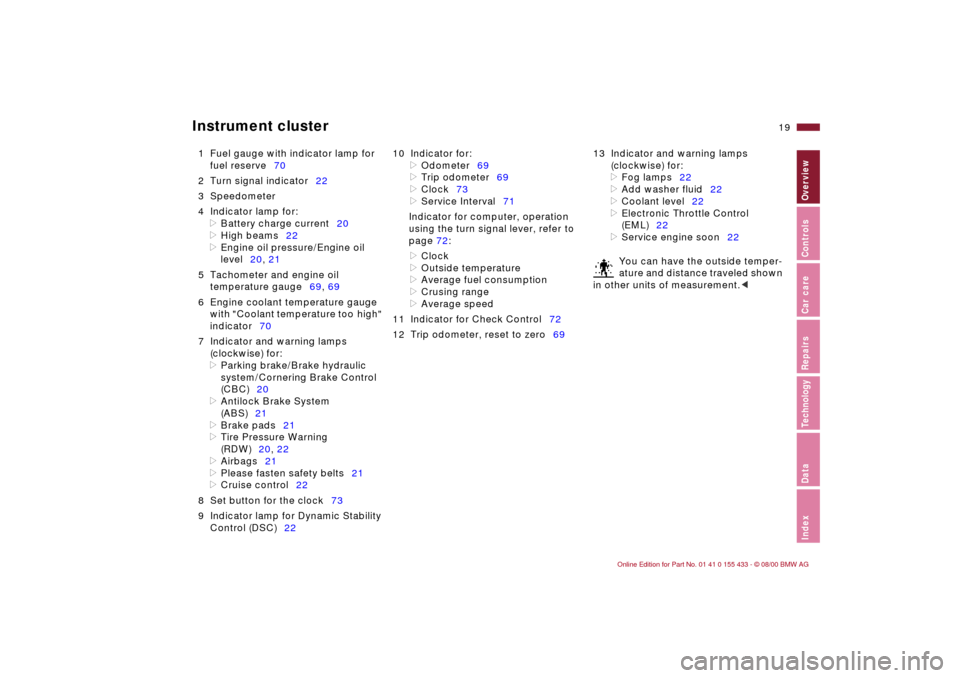
19n
IndexDataTechnologyRepairsCar careControlsOverview
Instrument cluster
1 Fuel gauge with indicator lamp for
fuel reserve70
2 Turn signal indicator22
3 Speedometer
4 Indicator lamp for:
>
Battery charge current20
>
High beams22
>
Engine oil pressure/Engine oil
level20, 21
5 Tachometer and engine oil
temperature gauge69, 69
6 Engine coolant temperature gauge
with "Coolant temperature too high"
indicator70
7 Indicator and warning lamps
(clockwise) for:
>
Parking brake/Brake hydraulic
system/Cornering Brake Control
(CBC)20
>
Antilock Brake System
(ABS)21
>
Brake pads21
>
Tire Pressure Warning
(RDW)20, 22
>
Airbags21
>
Please fasten safety belts21
>
Cruise control22
8 Set button for the clock73
9 Indicator lamp for Dynamic Stability
Control (DSC)2210 Indicator for:
>
Odometer69
>
Trip odometer69
>
Clock73
>
Service Interval71
Indicator for computer, operation
using the turn signal lever, refer to
page 72:
>
Clock
>
Outside temperature
>
Average fuel consumption
>
Crusing range
>
Average speed
11 Indicator for Check Control72
12 Trip odometer, reset to zero6913 Indicator and warning lamps
(clockwise) for:
>
Fog lamps22
>
Add washer fluid22
>
Coolant level22
>
Electronic Throttle Control
(EML)22
>
Service engine soon22
You can have the outside temper-
ature and distance traveled shown
in other units of measurement.
<
Page 20 of 183

20n
Indicator and warning lamps
Technology
that monitors itself
Many of the systems of your BMW
monitor themselves automatically, both
during engine starts and while you are
driving. Indicator and warning lamps
that are identified by "
l
" are tested for
proper functioning whenever the igni-
tion key is turned. They each light up
once for different periods of time.
If a fault should occur in one of these
systems, the corresponding lamp does
not go out after the engine is started or
it lights up while the vehicle is moving.
You will see how to react to this below.
Red: stop immediately
Battery charge current
l
The battery is no longer being
charged. There is a malfunction
of the alternator drive belt or in the
charging circuit of the alternator. Please
contact the nearest BMW center.
If the drive belt is defective, do not
continue driving. The engine could
be damaged due to overheating. If the
V-belt is defective, increased steering
effort is also required.
<
Engine oil pressure
l
Stop vehicle immediately and
switch off engine. Check the
engine oil level and top up as required.
If the oil level is correct: please contact
the nearest BMW center.
Do not continue driving, other-
wise, the engine could be
damaged because of inadequate lubri-
cation.
<
Tire Pressure Warning (RDW)
In addition, an acoustic signal is
sounded: a flat tire has
occurred. To come to an immediate
stop, reduce speed, while avoiding any
sudden, jerky braking or steering
maneuvers.
For additional information, refer to
page 78.
Brake hydraulic system
l
If the lamp comes on when the
parking brake is not engaged:
Check the brake fluid level. Before
driving further, be sure to read the addi-
tional information on pages 107
and 126.
Brake lamp for Canadian
models.
Page 21 of 183
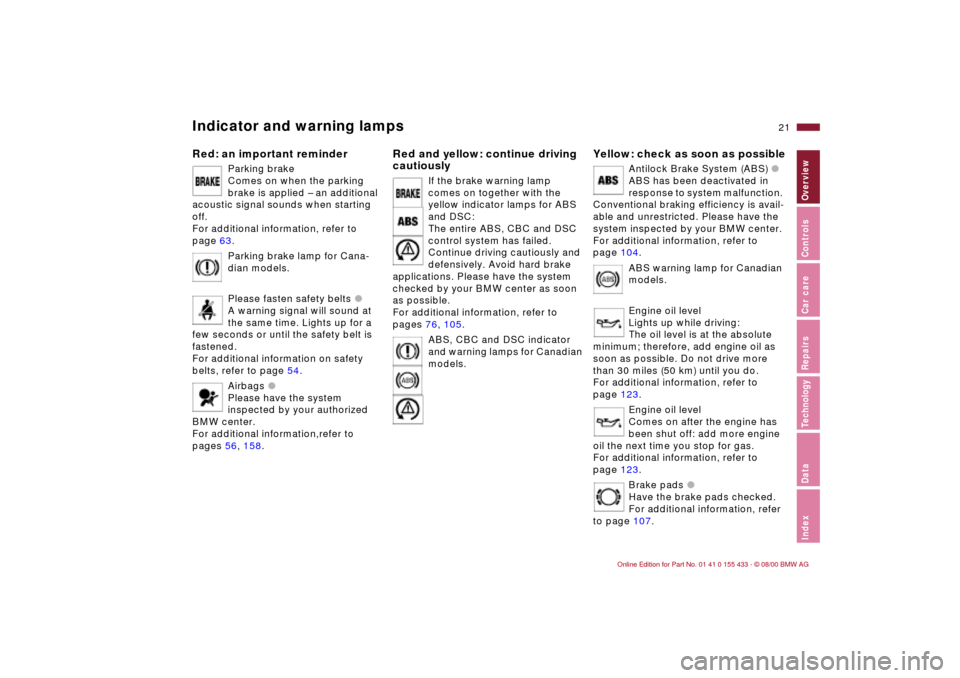
21n
IndexDataTechnologyRepairsCar careControlsOverview
Indicator and warning lamps
Red: an important reminder
Parking brake
Comes on when the parking
brake is applied Ð an additional
acoustic signal sounds when starting
off.
For additional information, refer to
page 63.
Parking brake lamp for Cana-
dian models.
Please fasten safety belts
l
A warning signal will sound at
the same time. Lights up for a
few seconds or until the safety belt is
fastened.
For additional information on safety
belts, refer to page 54.
Airbags
l
Please have the system
inspected by your authorized
BMW center.
For additional information,refer to
pages 56, 158.
Red and yellow: continue driving
cautiously
If the brake warning lamp
comes on together with the
yellow indicator lamps for ABS
and DSC:
The entire ABS, CBC and DSC
control system has failed.
Continue driving cautiously and
defensively. Avoid hard brake
applications. Please have the system
checked by your BMW center as soon
as possible.
For additional information, refer to
pages 76, 105.
ABS, CBC and DSC indicator
and warning lamps for Canadian
models.
Yellow: check as soon as possible
Antilock Brake System (ABS) l
ABS has been deactivated in
response to system malfunction.
Conventional braking efficiency is avail-
able and unrestricted. Please have the
system inspected by your BMW center.
For additional information, refer to
page 104.
ABS warning lamp for Canadian
models.
Engine oil level
Lights up while driving:
The oil level is at the absolute
minimum; therefore, add engine oil as
soon as possible. Do not drive more
than 30 miles (50 km) until you do.
For additional information, refer to
page 123.
Engine oil level
Comes on after the engine has
been shut off: add more engine
oil the next time you stop for gas.
For additional information, refer to
page 123.
Brake pads l
Have the brake pads checked.
For additional information, refer
to page 107.
Page 28 of 183

28n
Locks and security systems:
Keys30
Electronic vehicle
immobilizer31
Central locking system31
Opening and closing Ð
via the door lock32
Opening and closing Ð
via the remote control33
Opening and closing Ð
from the inside36
Lugagge compartment lid37
Luggage compartment39
Alarm system40
Electric power windows42
Sliding/tilt sunroof43
Adjustments:
Seats45
Mirrors49
Seat and mirror memory51
Steering wheel52
Car Memory, Key Memory52
Passenger safety systems:
Safety belts54
Airbags56
Transporting children safely59
Controls
Page 45 of 183
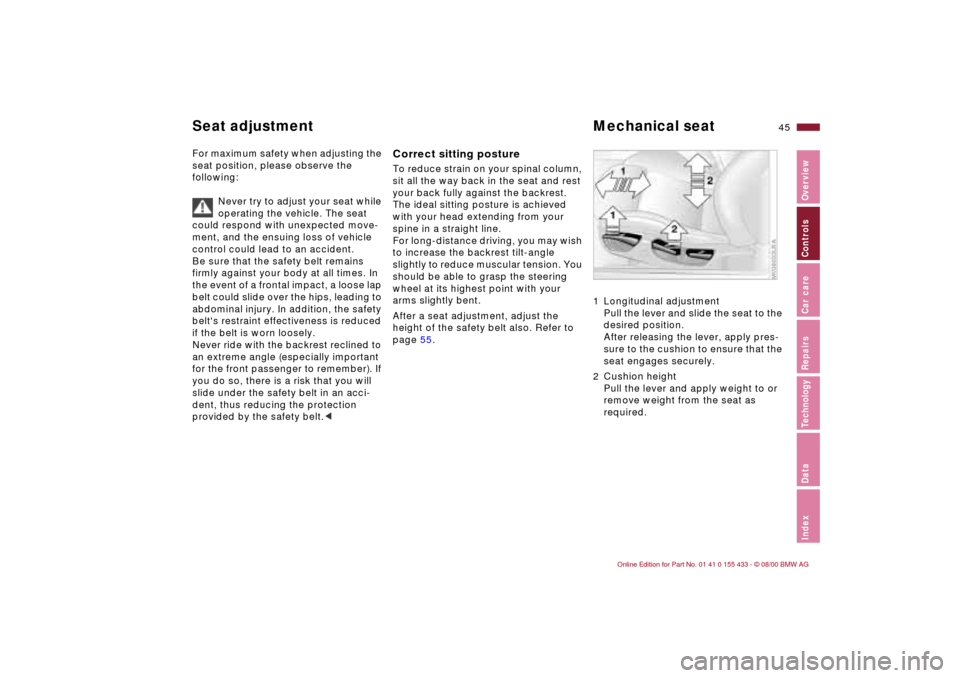
45n
IndexDataTechnologyRepairsCar careControlsOverview
For maximum safety when adjusting the
seat position, please observe the
following:
Never try to adjust your seat while
operating the vehicle. The seat
could respond with unexpected move-
ment, and the ensuing loss of vehicle
control could lead to an accident.
Be sure that the safety belt remains
firmly against your body at all times. In
the event of a frontal impact, a loose lap
belt could slide over the hips, leading to
abdominal injury. In addition, the safety
belt's restraint effectiveness is reduced
if the belt is worn loosely.
Never ride with the backrest reclined to
an extreme angle (especially important
for the front passenger to remember). If
you do so, there is a risk that you will
slide under the safety belt in an acci-
dent, thus reducing the protection
provided by the safety belt.<
Correct sitting posture To reduce strain on your spinal column,
sit all the way back in the seat and rest
your back fully against the backrest.
The ideal sitting posture is achieved
with your head extending from your
spine in a straight line.
For long-distance driving, you may wish
to increase the backrest tilt-angle
slightly to reduce muscular tension. You
should be able to grasp the steering
wheel at its highest point with your
arms slightly bent.
After a seat adjustment, adjust the
height of the safety belt also. Refer to
page 55. 1 Longitudinal adjustment
Pull the lever and slide the seat to the
desired position.
After releasing the lever, apply pres-
sure to the cushion to ensure that the
seat engages securely.
2 Cushion height
Pull the lever and apply weight to or
remove weight from the seat as
required.
Seat adjustment Mechanical seat
Page 54 of 183
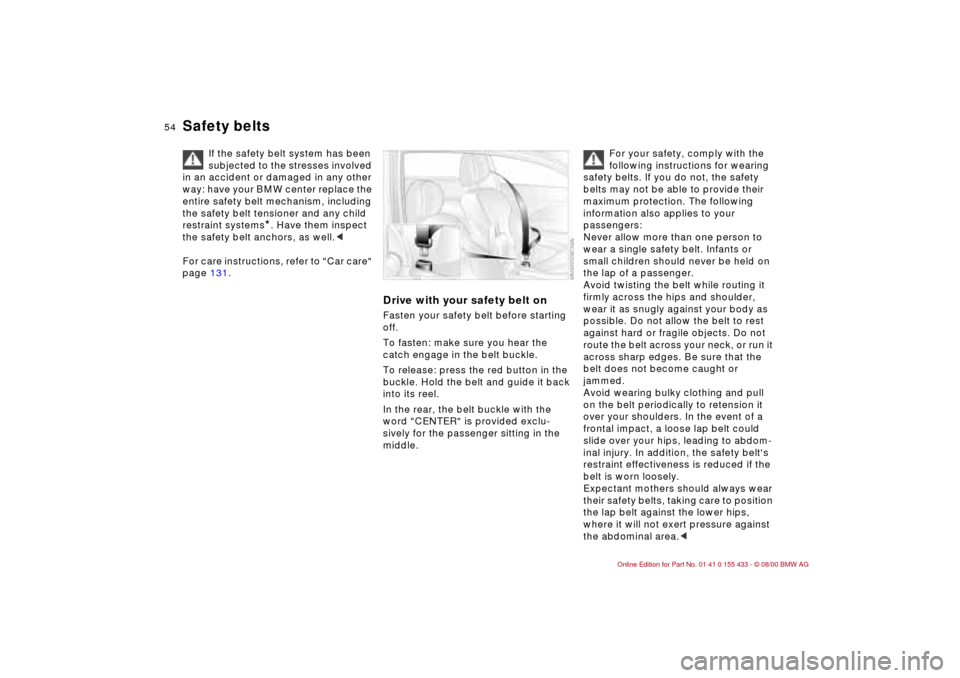
54n
If the safety belt system has been
subjected to the stresses involved
in an accident or damaged in any other
way: have your BMW center replace the
entire safety belt mechanism, including
the safety belt tensioner and any child
restraint systems
*. Have them inspect
the safety belt anchors, as well.<
For care instructions, refer to "Car care"
page 131.
Drive with your safety belt onFasten your safety belt before starting
off.
To fasten: make sure you hear the
catch engage in the belt buckle.
To release: press the red button in the
buckle. Hold the belt and guide it back
into its reel.
In the rear, the belt buckle with the
word "CENTER" is provided exclu-
sively for the passenger sitting in the
middle.
For your safety, comply with the
following instructions for wearing
safety belts. If you do not, the safety
belts may not be able to provide their
maximum protection. The following
information also applies to your
passengers:
Never allow more than one person to
wear a single safety belt. Infants or
small children should never be held on
the lap of a passenger.
Avoid twisting the belt while routing it
firmly across the hips and shoulder,
wear it as snugly against your body as
possible. Do not allow the belt to rest
against hard or fragile objects. Do not
route the belt across your neck, or run it
across sharp edges. Be sure that the
belt does not become caught or
jammed.
Avoid wearing bulky clothing and pull
on the belt periodically to retension it
over your shoulders. In the event of a
frontal impact, a loose lap belt could
slide over your hips, leading to abdom-
inal injury. In addition, the safety belt's
restraint effectiveness is reduced if the
belt is worn loosely.
Expectant mothers should always wear
their safety belts, taking care to position
the lap belt against the lower hips,
where it will not exert pressure against
the abdominal area.<
Safety belts
Page 55 of 183
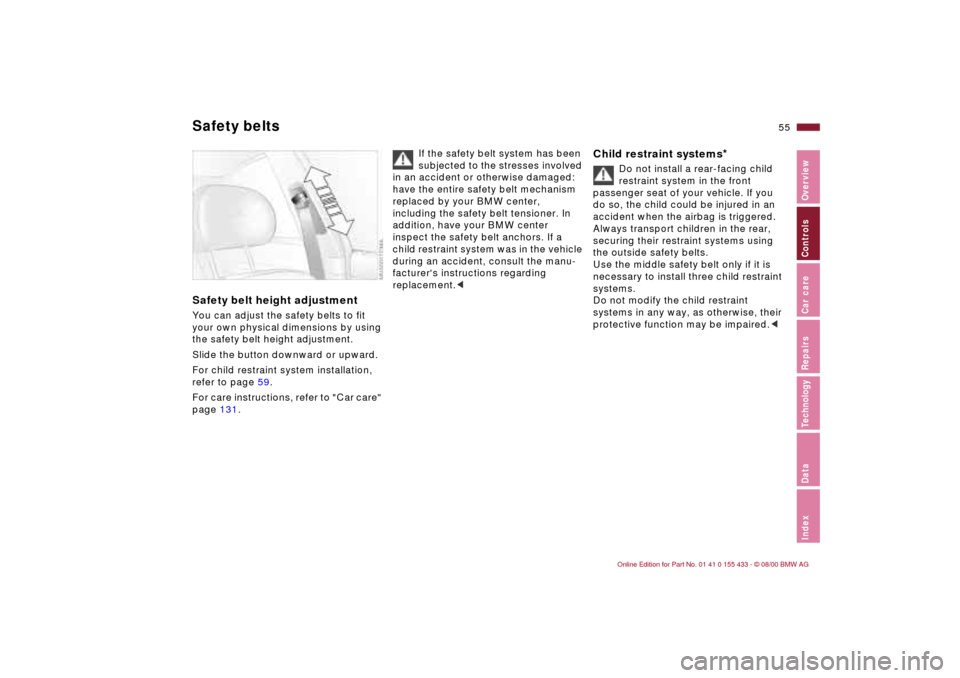
55n
IndexDataTechnologyRepairsCar careControlsOverview
Safety beltsSafety belt height adjustmentYou can adjust the safety belts to fit
your own physical dimensions by using
the safety belt height adjustment.
Slide the button downward or upward.
For child restraint system installation,
refer to page 59.
For care instructions, refer to "Car care"
page 131.
If the safety belt system has been
subjected to the stresses involved
in an accident or otherwise damaged:
have the entire safety belt mechanism
replaced by your BMW center,
including the safety belt tensioner. In
addition, have your BMW center
inspect the safety belt anchors. If a
child restraint system was in the vehicle
during an accident, consult the manu-
facturer's instructions regarding
replacement.<
Child restraint systems
*
Do not install a rear-facing child
restraint system in the front
passenger seat of your vehicle. If you
do so, the child could be injured in an
accident when the airbag is triggered.
Always transport children in the rear,
securing their restraint systems using
the outside safety belts.
Use the middle safety belt only if it is
necessary to install three child restraint
systems.
Do not modify the child restraint
systems in any way, as otherwise, their
protective function may be impaired.<
Page 56 of 183

56n
Airbags 1 Front airbags on the driver and
passenger sides
2 Side impact Head Protection System
on the driver's side (front)
3 Side airbags on the driver and
passenger sides (front and rear
*)
Protective effectThe front airbags provide additional
protection for the front-seat occupants
in the event of a severe frontal collision
on which the protection afforded by the
belts alone may no longer be sufficient.
The side impact Head Protection
System and the side airbags help
provide protection in the event of a
collision from the side. Each of the side
airbags is designed to help support the
occupant's upper body.
The side airbags in the rear
passenger area
* of your vehicle
may already have been deactivated
either at the time of manufacture or by a
BMW center. You may have them acti-
vated if you desire to do so. Please
contact your BMW center for additional
information.<
The illustration schematically depicts
the primary directions of vehicle impact
that initiate an airbag deployment.
The airbags will not be triggered in
the event of a minor accident, a
vehicle roll-over or collisions from the
rear.<
Functional status
The indicator lamp in the instru-
ment cluster shows the airbag
system status starting in ignition
key position 1.
Indicator lamp displays:
>The indicator lamp comes on briefly
then goes out: system operational
>The indicator lamp fails to come on:
system malfunction
>The indicator lamp comes on briefly
before going out, and then lights up
again: system malfunction.
If there is a system malfunction, there is
a risk that the airbags will not be trig-
gered within their normal response
range, even if the level of impact would
normally have triggered them.
Have the system checked by a BMW
center immediately.
The airbag indicator lamp also
comes on if the safety belt
tensioners have been triggered.<